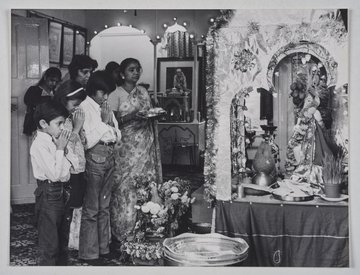
Religion
South Asians in Britain have engaged in diverse religious practices, establishing sites of worship and communities of faith around the United Kingdom
Overview
Christian missionaries were heavily engaged in the enterprise of the British empire. This extended to evangelizing South Asians in Britain from the early nineteenth century. Joseph Salter was a Christian missionary who worked with seafarers in the East End of London and then worked for the Strangers’ Home for Asiatics, Africans and South Sea Islanders. The London City Mission also set up the Ayahs’ Home in Hackney. South Asians acted as Christian missionaries and ministers as well, including E. B. Bhose of St Luke’s Lascars Mission and Kamal Chunchie, the Methodist minister who founded the Coloured Men’s Institute.
Religious leaders from South Asia also visited Britain in the nineteenth century to exchange ideas. Visitors included Rammohun Roy and Keshub Chunder Sen from the Brahmo Samaj, Yusuf Khan, who followed the Sulaimani religion, and later Swami Vivekananda and Purohit Swami. The Theosophical Society, founded in 1875 by Madame Blavatsky, was particularly interested in religious traditions from South Asia and brought over several young Indians such as Mohini Chatterjee and Jiddu Krishnamurti. Debates on social and religious reform often centred around South Asians in Britain, such as the case of the child marriage of Rukhmabai, which was a concern for reformer Behramji Malabari.
South Asian communities have established sites of worship across the United Kingdom. Some of these have been temporary and some built more recently. Examples include the Shah Jahan Mosque, Woking (1889), the Liverpool Mosque (1891), the East London Mosque (1941), Sikh Dharamsala (London, 1911) and Scotland’s first gurdwara (Glasgow, 1952). Other important organizations include the Zoroastrian Association (1861), the Indian Cultural Centre in Cardiff (1970) and the Northern Ireland Sikh Association (1995). As well as being places of worship, these religious sites were often hubs for communities to gather and support one another. For example, the Jamiat-ul-Muslimin, established in 1934 and based at the East London Mosque, provided help and education to poor Muslims in the area, among other things.
Religious conflict in South Asia has also affected communities in the United Kingdom. Following the partition of India and Pakistan in 1947, many South Asians migrated to the United Kingdom. British Bengali communities were involved in support for an independent Bangladesh in 1971. In 1984, following Operation Blue Star, 25,000 Sikhs from across Britain marched from Hyde Park to the Indian High Commission, with some chanting ‘Khalistan Zindabad’ in support of a separate Sikh state. South Asians in Britain have also been targeted negatively because of their religious identities. Muslims in particular have experienced Islamophobic abuse and hate crime, especially since the Satanic Verses affair of 1989, the terror attacks of 11 September 2001 and the London transport bombings of 7 July 2005. South Asian writers and artists who have critically engaged with these varied contexts include Jamila Gavin (her Surya trilogy), Mohammed Ali (his mural Mateer Tan), the Singh Twins (their artwork Nineteen Eighty-Four), Hanif Kureishi (his novel The Black Album) and Kamila Shamsie (her novel Home Fire).
Another interesting thing
South Asians in Britain have been engaged in interfaith dialogue and community building. Abdool Alli, of Indo-Guyanese descent, championed interfaith dialogue in Haringey through the London Islamic Cultural Society, and Sewa Singh Kohli was committed to interfaith dialogue and cultural engagement among Glasgow’s South Asian communities. South Asians have also engaged in numerous interfaith marriages, with examples such as Samuel Rahamin (Jewish) and Atiya Begum (Muslim); Shapurji Saklatvala (Parsee) and Sarah Marsh (Christian); Kabir Bedi (Sikh) and Freda Houlston (Christian), who later became a Buddhist nun.
Browse this theme
Image credit
Photograph, gelatin silver print by Henry Grant, HG2828/7.1, © Henry Grant Collection/London Museum, https://creativecommons.org/licenses/by-nc/4.0/
